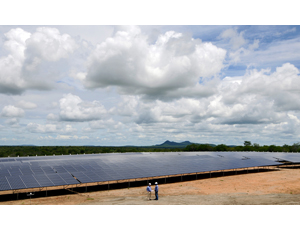
Brazil’s equatorial latitude guarantees that the country is perpetually sun-drenched. The monthly average of sunlight hours is roughly double that in, for example, Germany. Yet, so far, the South American giant’s solar energy development has been eclipsed by Europe’s. The situation is beginning to change, however, as Brazil's healthy, expansive economy requires more and more energy. The forecast for increasing electricity demand is pushing development in the solar part of the renewable-energy sector.
The Brazilian Agency of Electric Energy (ANEEL) published a resolution this year that defines the rules for consumers willing to generate their own energy from alternative sources. The policy applies to small energy generators producing less than one megawatt.
Máximo Luiz Pompermeyer, superintendent of ANEEL's energy research, development and efficiency efforts, explains that the resolution “is part of an effort to reduce regulatory barriers to the use of alternative energy” in Brazil.
ANEEL also has implemented an incentive program to stimulate research and development in renewables. So far, the initiative has advanced 18 public and private photovoltaic energy projects—worth $410 million reais, or U.S. $68.4 million—which account for 25 MW of total installed capacity. CPFL Energia will be the first company to start operating its project, which has been scheduled for November. CPFL, a privately held utility company, is the third-largest utility in Brazil. Headquartered in Campinas, Sao Paulo, the corporation counts construction conglomerate Camargo Corrêa as one of its largest shareholders.
Brazilian solar-power supporters complain the government does little to encourage capital development. To date, there has been no government support for solar power in the Brazilian energy futures market.
Leônidas Andrade—director of the photovoltaic-systems sector group of the Brazilian Association of Electric & Electronic Industry (ABINEE), which was created last year—wants to see support of the sector’s production chain so that demand can grow.
He also believes the industry should be deregulated because system implementation costs remain high. “The learning curve of solar power has to be developed, although the government does not set it as a priority. We think that it has to be done once we have already gained competitiveness,” he states.
Importing Technology
Because Brazil’s domestic market has not fully mastered solar technology, foreign companies are getting interested.
Ricardo Herbst, international director of business development for Solac Solar AG, the German photovoltaic-systems producer, says his employer, which typically performs as developer and investor on an engineer-procure-construct (EPC) basis, has been securing its foothold in the Brazilian market. “Brazil has a very significant potential," he says. With an installed capacity of 25,000 MW, “the German market is saturated,” he adds.
Sybac’s representative is in Brazil searching for partnership opportunities, a prerequisite for international companies willing to supply engineering, technology and photovoltaic equipment to installers. Even with in-country assembly arrangements or production based in Brazil, ABINEE still regards local partnerships as a prudent step for international investors because guaranteed demand has not yet developed.
"Solar power is advantageous when it can be supplied near consumers, which decreases implementation costs,” says Miguel Ornelas, a manager with Asumin, a Portuguese distributor of solar photovoltaic systems. The firm already has projects being implemented in northeastern Brazil, which, along with central-western Brazil, is considered the most advantageous area for solar farms.
Low Installed Capacity
The government’s most recent 10-year energy plan, divulged at the end of last year, points out that, of the Brazilian grid's existing total of 115,162 MW, the installed solar capacity is only one megawatt.
Hydroelectric plants generate 67% of the nation’s energy. Another 30 MW are generated by off-grid systems, unconnected to the public energy network; the largest is the government’s rural electrification program, called “Light for Everybody.”
Another renewable-energy source, wind, has faced many of the same difficulties as solar gaining a foothold in Brazil, despite the country’s 8,000 kilometers of coast. Currently, there are several wind-energy equipment companies set up, and the segment has already participated in energy futures auctions. By 2021, according to the 10-year energy plan, wind power will represent 9% of the whole energy generated in Brazil.
Solar energy’s adherents hope their efforts will follow a similar track.


Post a comment to this article
Report Abusive Comment